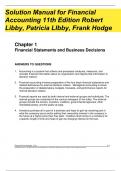Tentamen (uitwerkingen)
Solution Manual for Financial Accounting 11th Edition Robert Libby, Patricia Libby, Frank Hodge
- Vak
- Instelling
- Boek
Solution Manual for Financial Accounting 11th Edition Robert Libby, Patricia Libby, Frank Hodge
[Meer zien]



